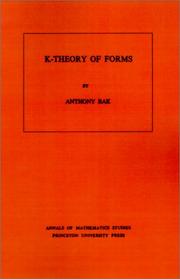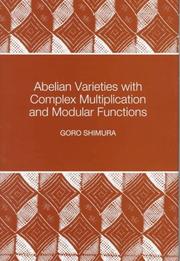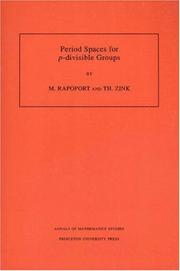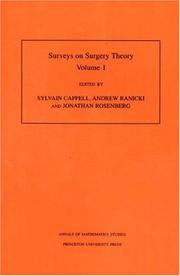| Listing 1 - 7 of 7 |
Sort by
|

ISBN: 069108274X 0691082758 1400881412 9780691082752 9780691082745 Year: 1981 Volume: 98 Publisher: Princeton (N.J.): Princeton university press,
Abstract | Keywords | Export | Availability | Bookmark
 Loading...
Loading...Choose an application
- Reference Manager
- EndNote
- RefWorks (Direct export to RefWorks)
The description for this book, K-Theory of Forms. (AM-98), Volume 98, will be forthcoming.
Category theory. Homological algebra --- 515.14 --- Algebraic topology --- 515.14 Algebraic topology --- Forms (Mathematics) --- K-theory --- Modules (Algebra) --- Finite number systems --- Modular systems (Algebra) --- Algebra --- Finite groups --- Rings (Algebra) --- Homology theory --- Quantics --- Mathematics --- K-theory. --- Abelian group. --- Addition. --- Algebraic K-theory. --- Algebraic topology. --- Approximation. --- Arithmetic. --- Canonical map. --- Coefficient. --- Cokernel. --- Computation. --- Coprime integers. --- Coset. --- Direct limit. --- Direct product. --- Division ring. --- Elementary matrix. --- Exact sequence. --- Finite group. --- Finite ring. --- Free module. --- Functor. --- General linear group. --- Global field. --- Group homomorphism. --- Group ring. --- Homology (mathematics). --- Integer. --- Invertible matrix. --- Isomorphism class. --- Linear map. --- Local field. --- Matrix group. --- Maxima and minima. --- Mayer–Vietoris sequence. --- Module (mathematics). --- Monoid. --- Morphism. --- Natural transformation. --- Normal subgroup. --- P-group. --- Parameter. --- Power of two. --- Product category. --- Projective module. --- Quadratic form. --- Requirement. --- Ring of integers. --- Semisimple algebra. --- Sesquilinear form. --- Special case. --- Steinberg group (K-theory). --- Steinberg group. --- Subcategory. --- Subgroup. --- Subspace topology. --- Surjective function. --- Theorem. --- Theory. --- Topological group. --- Topological ring. --- Topology. --- Torsion subgroup. --- Triviality (mathematics). --- Unification (computer science). --- Unitary group. --- Witt group. --- K-théorie

ISBN: 0691016569 1400883946 9780691016566 Year: 1998 Volume: 46 Publisher: Princeton (N.J.): Princeton university press,
Abstract | Keywords | Export | Availability | Bookmark
 Loading...
Loading...Choose an application
- Reference Manager
- EndNote
- RefWorks (Direct export to RefWorks)
Reciprocity laws of various kinds play a central role in number theory. In the easiest case, one obtains a transparent formulation by means of roots of unity, which are special values of exponential functions. A similar theory can be developed for special values of elliptic or elliptic modular functions, and is called complex multiplication of such functions. In 1900 Hilbert proposed the generalization of these as the twelfth of his famous problems. In this book, Goro Shimura provides the most comprehensive generalizations of this type by stating several reciprocity laws in terms of abelian varieties, theta functions, and modular functions of several variables, including Siegel modular functions. This subject is closely connected with the zeta function of an abelian variety, which is also covered as a main theme in the book. The third topic explored by Shimura is the various algebraic relations among the periods of abelian integrals. The investigation of such algebraicity is relatively new, but has attracted the interest of increasingly many researchers. Many of the topics discussed in this book have not been covered before. In particular, this is the first book in which the topics of various algebraic relations among the periods of abelian integrals, as well as the special values of theta and Siegel modular functions, are treated extensively.
Ordered algebraic structures --- 512.74 --- Abelian varieties --- Modular functions --- Functions, Modular --- Elliptic functions --- Group theory --- Number theory --- Varieties, Abelian --- Geometry, Algebraic --- Algebraic groups. Abelian varieties --- 512.74 Algebraic groups. Abelian varieties --- Abelian varieties. --- Modular functions. --- Abelian extension. --- Abelian group. --- Abelian variety. --- Absolute value. --- Adele ring. --- Affine space. --- Affine variety. --- Algebraic closure. --- Algebraic equation. --- Algebraic extension. --- Algebraic number field. --- Algebraic structure. --- Algebraic variety. --- Analytic manifold. --- Automorphic function. --- Automorphism. --- Big O notation. --- CM-field. --- Characteristic polynomial. --- Class field theory. --- Coefficient. --- Complete variety. --- Complex conjugate. --- Complex multiplication. --- Complex number. --- Complex torus. --- Corollary. --- Degenerate bilinear form. --- Differential form. --- Direct product. --- Direct proof. --- Discrete valuation ring. --- Divisor. --- Eigenvalues and eigenvectors. --- Embedding. --- Endomorphism. --- Existential quantification. --- Field of fractions. --- Finite field. --- Fractional ideal. --- Function (mathematics). --- Fundamental theorem. --- Galois extension. --- Galois group. --- Galois theory. --- Generic point. --- Ground field. --- Group theory. --- Groupoid. --- Hecke character. --- Homology (mathematics). --- Homomorphism. --- Identity element. --- Integer. --- Irreducibility (mathematics). --- Irreducible representation. --- Lie group. --- Linear combination. --- Linear subspace. --- Local ring. --- Modular form. --- Natural number. --- Number theory. --- Polynomial. --- Prime factor. --- Prime ideal. --- Projective space. --- Projective variety. --- Rational function. --- Rational mapping. --- Rational number. --- Real number. --- Residue field. --- Riemann hypothesis. --- Root of unity. --- Scientific notation. --- Semisimple algebra. --- Simple algebra. --- Singular value. --- Special case. --- Subgroup. --- Subring. --- Subset. --- Summation. --- Theorem. --- Vector space. --- Zero element.

ISBN: 0691027811 1400882605 9780691027814 Year: 1996 Volume: 141 Publisher: Princeton (N.J.): Princeton university press,
Abstract | Keywords | Export | Availability | Bookmark
 Loading...
Loading...Choose an application
- Reference Manager
- EndNote
- RefWorks (Direct export to RefWorks)
In this monograph p-adic period domains are associated to arbitrary reductive groups. Using the concept of rigid-analytic period maps the relation of p-adic period domains to moduli space of p-divisible groups is investigated. In addition, non-archimedean uniformization theorems for general Shimura varieties are established. The exposition includes background material on Grothendieck's "mysterious functor" (Fontaine theory), on moduli problems of p-divisible groups, on rigid analytic spaces, and on the theory of Shimura varieties, as well as an exposition of some aspects of Drinfelds' original construction. In addition, the material is illustrated throughout the book with numerous examples.
p-adic groups --- p-divisible groups --- Moduli theory --- 512.7 --- Theory of moduli --- Analytic spaces --- Functions of several complex variables --- Geometry, Algebraic --- Groups, p-divisible --- Group schemes (Mathematics) --- Groups, p-adic --- Group theory --- Algebraic geometry. Commutative rings and algebras --- 512.7 Algebraic geometry. Commutative rings and algebras --- p-divisible groups. --- Moduli theory. --- p-adic groups. --- Abelian variety. --- Addition. --- Alexander Grothendieck. --- Algebraic closure. --- Algebraic number field. --- Algebraic space. --- Algebraically closed field. --- Artinian ring. --- Automorphism. --- Base change. --- Basis (linear algebra). --- Big O notation. --- Bilinear form. --- Canonical map. --- Cohomology. --- Cokernel. --- Commutative algebra. --- Commutative ring. --- Complex multiplication. --- Conjecture. --- Covering space. --- Degenerate bilinear form. --- Diagram (category theory). --- Dimension (vector space). --- Dimension. --- Duality (mathematics). --- Elementary function. --- Epimorphism. --- Equation. --- Existential quantification. --- Fiber bundle. --- Field of fractions. --- Finite field. --- Formal scheme. --- Functor. --- Galois group. --- General linear group. --- Geometric invariant theory. --- Hensel's lemma. --- Homomorphism. --- Initial and terminal objects. --- Inner automorphism. --- Integral domain. --- Irreducible component. --- Isogeny. --- Isomorphism class. --- Linear algebra. --- Linear algebraic group. --- Local ring. --- Local system. --- Mathematical induction. --- Maximal ideal. --- Maximal torus. --- Module (mathematics). --- Moduli space. --- Monomorphism. --- Morita equivalence. --- Morphism. --- Multiplicative group. --- Noetherian ring. --- Open set. --- Orthogonal basis. --- Orthogonal complement. --- Orthonormal basis. --- P-adic number. --- Parity (mathematics). --- Period mapping. --- Prime element. --- Prime number. --- Projective line. --- Projective space. --- Quaternion algebra. --- Reductive group. --- Residue field. --- Rigid analytic space. --- Semisimple algebra. --- Sheaf (mathematics). --- Shimura variety. --- Special case. --- Subalgebra. --- Subgroup. --- Subset. --- Summation. --- Supersingular elliptic curve. --- Support (mathematics). --- Surjective function. --- Symmetric bilinear form. --- Symmetric space. --- Tate module. --- Tensor algebra. --- Tensor product. --- Theorem. --- Topological ring. --- Topology. --- Torsor (algebraic geometry). --- Uniformization theorem. --- Uniformization. --- Unitary group. --- Weil group. --- Zariski topology.

ISBN: 0691049386 0691088152 1322055211 1400865190 0691049378 1322063281 1400865212 0691088144 9781400865192 9780691049380 9780691049373 9781400865215 9780691088150 9780691088150 9780691088143 Year: 2001 Volume: 145,149 Publisher: Princeton, New Jersey Oxfordshire, England
Abstract | Keywords | Export | Availability | Bookmark
 Loading...
Loading...Choose an application
- Reference Manager
- EndNote
- RefWorks (Direct export to RefWorks)
Surgery theory, the basis for the classification theory of manifolds, is now about forty years old. There have been some extraordinary accomplishments in that time, which have led to enormously varied interactions with algebra, analysis, and geometry. Workers in many of these areas have often lamented the lack of a single source that surveys surgery theory and its applications. Indeed, no one person could write such a survey. The sixtieth birthday of C. T. C. Wall, one of the leaders of the founding generation of surgery theory, provided an opportunity to rectify the situation and produce a comprehensive book on the subject. Experts have written state-of-the-art reports that will be of broad interest to all those interested in topology, not only graduate students and mathematicians, but mathematical physicists as well. Contributors include J. Milnor, S. Novikov, W. Browder, T. Lance, E. Brown, M. Kreck, J. Klein, M. Davis, J. Davis, I. Hambleton, L. Taylor, C. Stark, E. Pedersen, W. Mio, J. Levine, K. Orr, J. Roe, J. Milgram, and C. Thomas.
Chirurgie (Topologie) --- Heelkunde (Topologie) --- Surgery (Topology) --- Differential topology --- Homotopy equivalences --- Manifolds (Mathematics) --- Topology --- Algebraic topology (object). --- Algebraic topology. --- Ambient isotopy. --- Assembly map. --- Atiyah–Hirzebruch spectral sequence. --- Atiyah–Singer index theorem. --- Automorphism. --- Banach algebra. --- Borsuk–Ulam theorem. --- C*-algebra. --- CW complex. --- Calculation. --- Category of manifolds. --- Characterization (mathematics). --- Chern class. --- Cobordism. --- Codimension. --- Cohomology. --- Compactification (mathematics). --- Conjecture. --- Contact geometry. --- Degeneracy (mathematics). --- Diagram (category theory). --- Diffeomorphism. --- Differentiable manifold. --- Differential geometry. --- Dirac operator. --- Disk (mathematics). --- Donaldson theory. --- Duality (mathematics). --- Embedding. --- Epimorphism. --- Excision theorem. --- Exponential map (Riemannian geometry). --- Fiber bundle. --- Fibration. --- Fundamental group. --- Group action. --- Group homomorphism. --- H-cobordism. --- Handle decomposition. --- Handlebody. --- Homeomorphism group. --- Homeomorphism. --- Homology (mathematics). --- Homomorphism. --- Homotopy extension property. --- Homotopy fiber. --- Homotopy group. --- Homotopy. --- Hypersurface. --- Intersection form (4-manifold). --- Intersection homology. --- Isomorphism class. --- K3 surface. --- L-theory. --- Limit (category theory). --- Manifold. --- Mapping cone (homological algebra). --- Mapping cylinder. --- Mostow rigidity theorem. --- Orthonormal basis. --- Parallelizable manifold. --- Poincaré conjecture. --- Product metric. --- Projection (linear algebra). --- Pushout (category theory). --- Quaternionic projective space. --- Quotient space (topology). --- Resolution of singularities. --- Ricci curvature. --- Riemann surface. --- Riemannian geometry. --- Riemannian manifold. --- Ring homomorphism. --- Scalar curvature. --- Semisimple algebra. --- Sheaf (mathematics). --- Sign (mathematics). --- Special case. --- Sub"ient. --- Subgroup. --- Submanifold. --- Support (mathematics). --- Surgery exact sequence. --- Surgery obstruction. --- Surgery theory. --- Symplectic geometry. --- Symplectic vector space. --- Theorem. --- Topological conjugacy. --- Topological manifold. --- Topology. --- Transversality (mathematics). --- Transversality theorem. --- Vector bundle. --- Waldhausen category. --- Whitehead torsion. --- Whitney embedding theorem. --- Yamabe invariant.
Book
ISBN: 0691080763 132288496X 0691620687 0691647429 1400869315 Year: 1970 Publisher: Princeton (N.J.) : Princeton university press,
Abstract | Keywords | Export | Availability | Bookmark
 Loading...
Loading...Choose an application
- Reference Manager
- EndNote
- RefWorks (Direct export to RefWorks)
The present volume reflects both the diversity of Bochner's pursuits in pure mathematics and the influence his example and thought have had upon contemporary researchers.Originally published in 1971.The Princeton Legacy Library uses the latest print-on-demand technology to again make available previously out-of-print books from the distinguished backlist of Princeton University Press. These editions preserve the original texts of these important books while presenting them in durable paperback and hardcover editions. The goal of the Princeton Legacy Library is to vastly increase access to the rich scholarly heritage found in the thousands of books published by Princeton University Press since its founding in 1905.
Mathematical analysis --- -Advanced calculus --- Analysis (Mathematics) --- Algebra --- Addresses, essays, lectures --- Mathematical analysis. --- -517.1 Mathematical analysis --- -Addresses, essays, lectures --- 517.1 Mathematical analysis --- 517.1. --- Approximation theory. --- System analysis. --- 517.1 --- Network analysis --- Network science --- Network theory --- Systems analysis --- System theory --- Mathematical optimization --- Theory of approximation --- Functional analysis --- Functions --- Polynomials --- Chebyshev systems --- Absolute continuity. --- Analytic continuation. --- Analytic function. --- Asymptotic expansion. --- Automorphism. --- Banach algebra. --- Banach space. --- Bessel function. --- Big O notation. --- Bounded operator. --- Branch point. --- Cauchy's integral formula. --- Cauchy's integral theorem. --- Characterization (mathematics). --- Cohomology. --- Commutative property. --- Compact operator. --- Compact space. --- Complex analysis. --- Complex number. --- Complex plane. --- Continuous function (set theory). --- Continuous function. --- Convolution. --- Coset. --- Covariance operator. --- Differentiable function. --- Differentiable manifold. --- Differential form. --- Dimension (vector space). --- Discrete group. --- Dominated convergence theorem. --- Eigenfunction. --- Eigenvalues and eigenvectors. --- Equation. --- Equivalence class. --- Even and odd functions. --- Existential quantification. --- First variation. --- Formal power series. --- Fréchet derivative. --- Fubini's theorem. --- Function space. --- Functional analysis. --- Fundamental group. --- Green's function. --- Haar measure. --- Hermite polynomials. --- Hermitian symmetric space. --- Holomorphic function. --- Hyperbolic partial differential equation. --- Infimum and supremum. --- Infinite product. --- Integral equation. --- Lebesgue measure. --- Lie algebra. --- Lie group. --- Linear map. --- Markov chain. --- Meromorphic function. --- Metric space. --- Monotonic function. --- Natural number. --- Norm (mathematics). --- Normal subgroup. --- Null set. --- Partition of unity. --- Pointwise. --- Polynomial. --- Power series. --- Pseudogroup. --- Riemann surface. --- Riemannian manifold. --- Schrödinger equation. --- Self-adjoint operator. --- Self-adjoint. --- Semigroup. --- Semisimple algebra. --- Sesquilinear form. --- Sign (mathematics). --- Singular perturbation. --- Special case. --- Spectral theory. --- Stokes' theorem. --- Subgroup. --- Submanifold. --- Subset. --- Support (mathematics). --- Symplectic geometry. --- Symplectic manifold. --- Theorem. --- Uniform convergence. --- Unitary operator. --- Unitary representation. --- Upper and lower bounds. --- Vector bundle. --- Vector field. --- Volterra's function. --- Weierstrass theorem. --- Zorn's lemma.
Book
ISBN: 0691082464 069161136X 1400871131 069163937X 9780691082462 Year: 1979 Publisher: Princeton (N.J.) : Princeton university press,
Abstract | Keywords | Export | Availability | Bookmark
 Loading...
Loading...Choose an application
- Reference Manager
- EndNote
- RefWorks (Direct export to RefWorks)
Based on a series of lectures given by Harish-Chandra at the Institute for Advanced Study in 1971-1973, this book provides an introduction to the theory of harmonic analysis on reductive p-adic groups.Originally published in 1979.The Princeton Legacy Library uses the latest print-on-demand technology to again make available previously out-of-print books from the distinguished backlist of Princeton University Press. These editions preserve the original texts of these important books while presenting them in durable paperback and hardcover editions. The goal of the Princeton Legacy Library is to vastly increase access to the rich scholarly heritage found in the thousands of books published by Princeton University Press since its founding in 1905.
512.74 --- p-adic groups --- Banach algebras --- Groups, p-adic --- Algebraic groups. Abelian varieties --- p-adic groups. --- 512.74 Algebraic groups. Abelian varieties --- P-adic groups. --- Harmonic analysis. Fourier analysis --- Harmonic analysis --- Analysis (Mathematics) --- Functions, Potential --- Potential functions --- Calculus --- Mathematical analysis --- Mathematics --- Bessel functions --- Fourier series --- Harmonic functions --- Time-series analysis --- Group theory --- Harmonic analysis. --- Adjoint representation. --- Admissible representation. --- Algebra homomorphism. --- Algebraic group. --- Analytic continuation. --- Analytic function. --- Associative property. --- Automorphic form. --- Automorphism. --- Banach space. --- Bijection. --- Bilinear form. --- Borel subgroup. --- Cartan subgroup. --- Central simple algebra. --- Characteristic function (probability theory). --- Characterization (mathematics). --- Class function (algebra). --- Commutative property. --- Compact space. --- Composition series. --- Conjugacy class. --- Corollary. --- Dimension (vector space). --- Discrete series representation. --- Division algebra. --- Double coset. --- Eigenvalues and eigenvectors. --- Endomorphism. --- Epimorphism. --- Equivalence class. --- Equivalence relation. --- Existential quantification. --- Factorization. --- Fourier series. --- Function (mathematics). --- Functional equation. --- Fundamental domain. --- Fundamental lemma (Langlands program). --- G-module. --- Group isomorphism. --- Haar measure. --- Hecke algebra. --- Holomorphic function. --- Identity element. --- Induced representation. --- Inner automorphism. --- Lebesgue measure. --- Levi decomposition. --- Lie algebra. --- Locally constant function. --- Locally integrable function. --- Mathematical induction. --- Matrix coefficient. --- Maximal compact subgroup. --- Meromorphic function. --- Module (mathematics). --- Module homomorphism. --- Open set. --- Order of integration (calculus). --- Orthogonal complement. --- P-adic number. --- Pole (complex analysis). --- Product measure. --- Projection (linear algebra). --- Quotient module. --- Quotient space (topology). --- Radon measure. --- Reductive group. --- Representation of a Lie group. --- Representation theorem. --- Representation theory. --- Ring homomorphism. --- Schwartz space. --- Semisimple algebra. --- Separable extension. --- Sesquilinear form. --- Set (mathematics). --- Sign (mathematics). --- Square-integrable function. --- Sub"ient. --- Subalgebra. --- Subgroup. --- Subset. --- Summation. --- Support (mathematics). --- Surjective function. --- Tempered representation. --- Tensor product. --- Theorem. --- Topological group. --- Topological space. --- Topology. --- Trace (linear algebra). --- Transitive relation. --- Unitary representation. --- Universal enveloping algebra. --- Variable (mathematics). --- Vector space. --- Analyse harmonique (mathématiques)
Book
ISBN: 0691233810 9780691233819 Year: 2022 Publisher: Princeton : Princeton University Press,
Abstract | Keywords | Export | Availability | Bookmark
 Loading...
Loading...Choose an application
- Reference Manager
- EndNote
- RefWorks (Direct export to RefWorks)
As the Roaring Twenties lurched into the Great Depression, to be followed by the scourge of Nazi Germany and World War II, American mathematicians pursued their research, positioned themselves collectively within American science, and rose to global mathematical hegemony. How did they do it? This book explores the institutional, financial, social, and political forces that shaped and supported this community in the first half of the 20th century. In doing so, Karen Hunger Parshall debunks the widely held view that American mathematics only thrived after European émigrés fled to the shores of the United States.
Mathematics --- HISTORY / United States / 20th Century. --- MATHEMATICS / History & Philosophy. --- Research. --- Research --- History --- United States. --- Math --- Science --- Mathematical research --- ABŞ --- ABSh --- Ameerika Ühendriigid --- America (Republic) --- Amerika Birlăshmish Shtatlary --- Amerika Birlăşmi Ştatları --- Amerika Birlăşmiş Ştatları --- Amerika ka Kelenyalen Jamanaw --- Amerika Qūrama Shtattary --- Amerika Qŭshma Shtatlari --- Amerika Qushma Shtattary --- Amerika (Republic) --- Amerikai Egyesült Államok --- Amerikanʹ Veĭtʹsėndi︠a︡vks Shtattnė --- Amerikări Pĕrleshu̇llĕ Shtatsem --- Amerikas Forenede Stater --- Amerikayi Miatsʻyal Nahangner --- Ameriketako Estatu Batuak --- Amirika Carékat --- AQSh --- Ar. ha-B. --- Arhab --- Artsot ha-Berit --- Artzois Ha'bris --- Bí-kok --- Ē.P.A. --- EE.UU. --- Egyesült Államok --- ĒPA --- Estados Unidos --- Estados Unidos da América do Norte --- Estados Unidos de América --- Estaos Xuníos --- Estaos Xuníos d'América --- Estatos Unitos --- Estatos Unitos d'America --- Estats Units d'Amèrica --- Ètats-Unis d'Amèrica --- États-Unis d'Amérique --- Fareyniḳṭe Shṭaṭn --- Feriene Steaten --- Feriene Steaten fan Amearika --- Forente stater --- FS --- Hēnomenai Politeiai Amerikēs --- Hēnōmenes Politeies tēs Amerikēs --- Hiwsisayin Amerikayi Miatsʻeal Tērutʻiwnkʻ --- Istadus Unidus --- Jungtinės Amerikos valstybės --- Mei guo --- Mei-kuo --- Meiguo --- Mî-koet --- Miatsʻyal Nahangner --- Miguk --- Na Stàitean Aonaichte --- NSA --- S.U.A. --- SAD --- Saharat ʻAmērikā --- SASht --- Severo-Amerikanskie Shtaty --- Severo-Amerikanskie Soedinennye Shtaty --- Si︠e︡vero-Amerikanskīe Soedinennye Shtaty --- Sjedinjene Američke Države --- Soedinennye Shtaty Ameriki --- Soedinennye Shtaty Severnoĭ Ameriki --- Soedinennye Shtaty Si︠e︡vernoĭ Ameriki --- Spojené obce severoamerické --- Spojené staty americké --- SShA --- Stadoù-Unanet Amerika --- Stáit Aontaithe Mheiriceá --- Stany Zjednoczone --- Stati Uniti --- Stati Uniti d'America --- Stâts Unîts --- Stâts Unîts di Americhe --- Steatyn Unnaneysit --- Steatyn Unnaneysit America --- SUA (Stati Uniti d'America) --- Sŭedineni amerikanski shtati --- Sŭedinenite shtati --- Tetã peteĩ reko Amérikagua --- U.S. --- U.S.A. --- United States of America --- Unol Daleithiau --- Unol Daleithiau America --- Unuiĝintaj Ŝtatoj de Ameriko --- US --- USA --- Usono --- Vaeinigte Staatn --- Vaeinigte Staatn vo Amerika --- Vereinigte Staaten --- Vereinigte Staaten von Amerika --- Verenigde State van Amerika --- Verenigde Staten --- VS --- VSA --- Wááshindoon Bikéyah Ałhidadiidzooígíí --- Wilāyāt al-Muttaḥidah --- Wilāyāt al-Muttaḥidah al-Amirīkīyah --- Wilāyāt al-Muttaḥidah al-Amrīkīyah --- Yhdysvallat --- Yunaeted Stet --- Yunaeted Stet blong Amerika --- ZDA --- Združene države Amerike --- Zʹi︠e︡dnani Derz︠h︡avy Ameryky --- Zjadnośone staty Ameriki --- Zluchanyi︠a︡ Shtaty Ameryki --- Zlucheni Derz︠h︡avy --- ZSA --- Η.Π.Α. --- Ηνωμένες Πολιτείες της Αμερικής --- Америка (Republic) --- Американь Вейтьсэндявкс Штаттнэ --- Америкӑри Пӗрлешӳллӗ Штатсем --- САЩ --- Съединените щати --- Злучаныя Штаты Амерыкі --- ولايات المتحدة --- ولايات المتّحدة الأمريكيّة --- ولايات المتحدة الامريكية --- 미국 --- États-Unis --- É.-U. --- ÉU --- Academia Sinica. --- Acta Arithmetica. --- Aftermath of World War II. --- American Association of Physics Teachers. --- American Council on Education. --- American Institute of Physics. --- American Journal of Mathematics. --- American Mathematical Monthly. --- American Mathematical Society. --- American Statistical Association. --- Analytic continuation. --- Annals of Mathematical Statistics. --- Annals of Mathematics. --- Annals of Science. --- Applied mathematics. --- Bulletin of the American Mathematical Society. --- Chancellor (education). --- Characterization (mathematics). --- Complex number. --- Connecticut College. --- Division algebra. --- Duke Mathematical Journal. --- Edward R. Murrow. --- Estimation theory. --- Euclidean space. --- European Mathematical Society. --- Fourier series. --- Fundamenta Mathematicae. --- Georg Cantor. --- Hilbert's fifth problem. --- Hyperbolic partial differential equation. --- Ideal (ring theory). --- International Congress of Mathematicians. --- Intersection theory. --- Introduction to general relativity. --- John von Neumann. --- Joint Policy Board for Mathematics. --- London Mathematical Society. --- Mathematical Association of America. --- Mathematical physics. --- Mathematical table. --- Mathematician. --- Mathematics. --- Methoden der mathematischen Physik. --- Minkowski space. --- National Council of Teachers of Mathematics. --- National Defense Research Committee. --- National Science Board. --- New Century. --- New Direction (think tank). --- New Math. --- New York Public Library. --- New York University Press. --- New York University. --- Nucleic acid sequence. --- Number theory. --- Patrician (ancient Rome). --- Physicist. --- Polish Academy of Sciences. --- Prime number theorem. --- Probability and statistics. --- Projection (mathematics). --- Purdue University. --- Pure mathematics. --- Quaternion algebra. --- Richard Dedekind. --- Riemann hypothesis. --- Riemannian geometry. --- Selective Training and Service Act of 1940. --- Semisimple algebra. --- Spectral theorem. --- Statistician. --- The Herald-Sun (Durham, North Carolina). --- Theoretical physics. --- Theory. --- Undergraduate degree. --- University of Notre Dame. --- Washington University in St. Louis. --- Whitney embedding theorem. --- Word problem (mathematics education). --- World war.
| Listing 1 - 7 of 7 |
Sort by
|

 Search
Search Feedback
Feedback About UniCat
About UniCat  Help
Help News
News